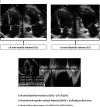Association of Left Atrial Function Index With Late Atrial Fibrillation Recurrence after Catheter Ablation
- PMID: 27569695
- PMCID: PMC5143220
- DOI: 10.1111/jce.13086
Association of Left Atrial Function Index With Late Atrial Fibrillation Recurrence after Catheter Ablation
Abstract
Introduction: Although catheter ablation (CA) for atrial fibrillation (AF) is commonly used to improve symptoms, AF recurrence is common and new tools are needed to better inform patient selection for CA. Left atrial function index (LAFI), an echocardiographic measure of atrial mechanical function, has shown promise as a noninvasive predictor of AF. We hypothesized that LAFI would relate to AF recurrence after CA.
Methods and results: All AF patients undergoing index CA were enrolled in a prospective institutional AF Treatment Registry between 2011 and 2014. LAFI was measured post hoc from pre-ablation clinical echocardiographic images in 168 participants. Participants were mostly male (33% female), middle-aged (60 ± 10 years), obese and had paroxysmal AF (64%). Mean LAFI was 25.9 ± 17.6. Over 12 months of follow-up, 78 participants (46%) experienced a late AF recurrence. In logistic regression analyses adjusting for factors known to be associated with AF, lower LAFI remained associated with AF recurrence after CA [OR 0.04 (0.01-0.67), P = 0.02]. LAFI discriminated AF recurrence after CA slightly better than CHADS2 (C-statistic 0.60 LAFI, 0.57 CHADS2). For participants with persistent AF, LAFI performed significantly better than CHADS2 score (C statistic = 0.79 LAFI, 0.56 CHADS2, P = 0.02).
Conclusion: LAFI, an echocardiographic measure of atrial function, is associated with AF recurrence after CA and has improved ability to discriminate AF recurrence as compared to the CHADS-2 score, especially among persistent AF patients. Since LAFI can be calculated using standard 2D echocardiographic images, it may be a helpful tool for predicting AF recurrence.
Keywords: arrhythmia recurrence; atrial fibrillation; atrial remodeling; catheter ablation; left atrial function index.
© 2016 Wiley Periodicals, Inc.
Figures




References
-
- Lloyd-Jones DM, Wang TJ, Leip EP, Larson MG, Levy D, Vasan RS, D'Agostino RB, Massaro JM, Beiser A, Wolf PA, Benjamin EJ. Lifetime risk for development of atrial fibrillation the Framingham heart study. Circulation. 2004;110.9:1042–1046. - PubMed
-
- Coyne KS, Paramore C, Grandy S, Mercader M, Reynolds M, Zimetbaum P. Assessing the direct costs of treating nonvalvular atrial fibrillation in the United States. Value Health. 2006;9:348–356. - PubMed
-
- Calkins H, Kuck KH, Cappato R, Brugada J, Camm AJ, Chen SA, Crijns HJ, Damiano RJ, Jr., Davies DW, DiMarco J, Edgerton J, Ellenbogen K, Ezekowitz MD, Haines DE, Haissaguerre M, Hindricks G, Iesaka Y, Jackman W, Jalife J, Jais P, Kalman J, Keane D, Kim YH, Kirchhof P, Klein G, Kottkamp H, Kumagai K, Lindsay BD, Mansour M, Marchlinski FE, McCarthy PM, Mont JL, Morady F, Nademanee K, Nakagawa H, Natale A, Nattel S, Packer DL, Pappone C, Prystowsky E, Raviele A, Reddy V, Ruskin JN, Shemin RJ, Tsao HM, Wilber D. 2012 HRS/EHRA/ECAS expert consensus statement on catheter and surgical ablation of atrial fibrillation. Heart rhythm. 2012;9:632–696. - PubMed
-
- Deshmukh A, Patel NJ, Pant S, Shah N, Chothani A, Mehta K, Grover P, Singh V, Vallurupalli S, Savani GT, Badheka A. Inhospital complications associated with catheter ablation of atrial fibrillation in the united states between 2000-2010: Analysis of 93,801 procedures. Circulation. 2013;128:2104–2112. - PubMed
-
- D'Ascenzo F, Corleto A, Biondi-Zoccai G, Anselmino M, Ferraris F, di Biase L, Natale A, Hunter RJ, Schilling RJ, Miyazaki S, Tada H, Aonuma K, Yenn-Jiang L, Tao H, Ma C, Packer D, Hammill S, Gaita F. Which are the most reliable predictors of recurrence of atrial fibrillation after transcatheter ablation? A meta-analysis. International journal of cardiology. 2013;167:1984–1989. - PubMed
Publication types
MeSH terms
Substances
Grants and funding
LinkOut - more resources
Full Text Sources
Other Literature Sources
Medical

